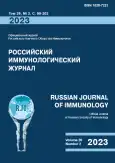Mathematical immunology: processes, models and data assimilation
- Authors: Grebennikov D.S.1,2, Zheltkova V.V.1,2, Savinkov R.S.1,2, Bocharov G.A.1,2
-
Affiliations:
- G. Marchuk Institute of Numerical Mathematics, Russian Academy of Sciences
- I. Sechenov First Moscow State Medical University
- Issue: Vol 26, No 2 (2023)
- Pages: 181-188
- Section: SHORT COMMUNICATIONS
- URL: https://journals.rcsi.science/1028-7221/article/view/253392
- DOI: https://doi.org/10.46235/1028-7221-1210-MIP
- ID: 253392
Cite item
Full Text
Abstract
The immune system is a complex multiscale multiphysical object. Understanding its functioning in the frame of systemic analysis implies the use of mathematical modelling, formulation of data consistency criterion, estimation of parameters, uncertainty analysis, and optimal model selection. In this work, we present some promising approaches to modelling the multi-physics immune processes, i.e., cell migration in lymph nodes (LN), lymph flow, homeostatic regulation of immune responses in chronic infections.
To describe the spatial-temporal dynamics of immune responses in lymph LN, we propose a model of lymphocyte migration, based on the second Newton’s law and considering three kinds of forces. The empirical distributions of three lymphocytes motility characteristics were used for model calibration using the Kolmogorov–Smirnov metric.
Prediction of lymph flow in a lymph node requires costly computations, due to diversity of sizes, forms, inner structure of LNs and boundary conditions. We proposed an approach to lymph flow modelling based on replacing the full-fledged computational physics-based model with an artificial neural network (ANN), trained on the set of pre-formed results computed using an initial mechanistic model. The ANN-based model reduces the computational time for some lymph flow characteristics by four orders of magnitude.
Calibration of Marchuk–Petrov model of antiviral immune response for SARS-CoV-2 infection was performed. To this end, we used previously published data on the viral load kinetics in nasopharynx of volunteers, and data on the observed ranges of interferon, antibodies and CTLs in the blood. The parameters, which have the most significant impact at different stages of infection process, were identified.
Inhibition of immune mechanisms, e.g., T cell exhaustion, is a distinctive feature of chronic viral infections and malignant diseases. We propose a mathematical model for the studies of regulation parameters of four exhausted T cell subsets in order to examine the balance of their proliferation and differentiation determined by interaction with SIRPa+ PD-L1+ and XCR+1 dendritic cells. The model parameters are evaluated, in order to study the reinvigoration effect of aPD-L1 therapy on the homeostasis of exhausted cells.
Full Text
##article.viewOnOriginalSite##About the authors
Dmitry S. Grebennikov
G. Marchuk Institute of Numerical Mathematics, Russian Academy of Sciences; I. Sechenov First Moscow State Medical University
Email: dmitry.ew@gmail.com
Junior Research Associate, G. Marchuk Institute of Numerical Mathematics, Russian Academy of Sciences; Research Associate, I. Sechenov First Moscow State Medical University, Moscow, Russian Federation
Russian Federation, Moscow; MoscowValeriya V. Zheltkova
G. Marchuk Institute of Numerical Mathematics, Russian Academy of Sciences; I. Sechenov First Moscow State Medical University
Author for correspondence.
Email: zheltkova_v_v@staff.sechenov.ru
Junior Research Associate, G. Marchuk Institute of Numerical Mathematics, Russian Academy of Sciences; Junior Research Associate, I. Sechenov First Moscow State Medical University, Moscow, Russian Federation
Russian Federation, Moscow; MoscowRostislav S. Savinkov
G. Marchuk Institute of Numerical Mathematics, Russian Academy of Sciences; I. Sechenov First Moscow State Medical University
Email: savinkov_r_s@staff.sechenov.ru
Junior Research Associate, G. Marchuk Institute of Numerical Mathematics, Russian Academy of Sciences; Junior Research Associate, I. Sechenov First Moscow State Medical University, Moscow, Russian Federation
Russian Federation, Moscow; MoscowGennady A. Bocharov
G. Marchuk Institute of Numerical Mathematics, Russian Academy of Sciences; I. Sechenov First Moscow State Medical University
Email: gbocharov@gmail.com
PhD, MD (Phys.-Math.), Leading Research Associate, G. Marchuk Institute of Numerical Mathematics, Russian Academy of Sciences; Professor, I. Sechenov First Moscow State Medical University, Moscow, Russian Federation
Russian Federation, Moscow; MoscowReferences
- Теребиж В.Ю. Введение в статистическую теорию обратных задач. М.: Физматлит, 2005. 375 с. [Terebyzh V.Yu. Introduction to the statistical theory of inverse problems]. Moscow: Fizmatlit, 2005. 375 p.
- Beltra J.C., Manne S., Abdel-Hakeem M.S., Kurachi M., Giles J.R., Chen Z., Casella V., Ngiow S.F., Khan O., Huang Y.J., Yan P., Nzingha K., Xu W., Amaravadi R.K., Xu X., Karakousis G.C., Mitchell T.C., Schuchter L.M., Huang A.C., Wherry E.J. Developmental relationships of four exhausted CD8+ T cell subsets reveals underlying transcriptional and epigenetic landscape control mechanisms. Immunity, 2020, Vol. 52, no. 5, pp. 825-841.e8.
- Bocharov G., Volpert V., Ludewig B., Meyerhans A. Mathematical immunology of virus infections. Cham, Switzerland: Springer International Publishing, 2018. 245 p.
- Grebennikov D., Bouchnita A., Volpert V., Bessonov N., Meyerhans A., Bocharov G. Spatial lymphocyte dynamics in lymph nodes predicts the cytotoxic T cell frequency needed for HIV infection control. Front. Immunol., 2019, Vol. 10, 1213. doi: 10.3389/fimmu.2019.01213.
- Grebennikov D., Karsonova A., Loguinova M., Casella V., Meyerhans A., Bocharov G. Predicting the kinetic coordination of immune response dynamics in SARS-CoV-2 infection: implications for disease pathogenesis. Mathematics, 2022, Vol. 10, no. 17, 3154. doi: 10.3390/math10173154.
- Grebennikov D., Zheltkova V., Bocharov, G. Application of minimum description length criterion to assess the complexity of models in mathematical immunology. Russian Journal of Numerical Analysis and Mathematical Modelling, 2022, Vol. 37, no. 5, pp 253-261.
- Tretiakova R., Setukha A., Savinkov R., Grebennikov D., Bocharov G. Mathematical modeling of lymph node drainage function by neural network. Mathematics, 2021, Vol. 9, no. 23, 3093. doi: 10.3390/math9233093.
- Zheltkova V., Argilaguet J., Peligero C., Bocharov G., Meyerhans A. Prediction of PD-L1 inhibition effects for HIV-infected individuals. PLoS Comput. Biol., 2019, Vol. 15, no. 11, e1007401. doi: 10.1371/journal.pcbi.1007401.
Supplementary files










